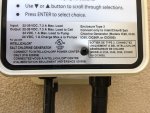Moved from here.. DIY Peristaltic Automation Questions
@Dirk
So I got a question for you on this one point.
Per your statement above, we both know that the IntelliChlor (and then consequently) the IpH will not work after H2O temp falls below 52F +/- 3F.
That fact is one of the things that bugs me about the system. I understand the reasoning but for those in moderate climates where the water temp just borders around 55, we still need a tad bit of chlorine and MA here and there throughout the winter months.
During those winter months, I detest lugging chem bottles to the edge of the pool with a plastic measuring cup like I used to do in the "old days".
So, what would happen if one were to cut the wires to the thermistor as was suggested in the thread below which I am following with some interest.
 www.troublefreepool.com
www.troublefreepool.com
As @Jimrahbe points out, the cell is then tricked into thinking that the H2O temp is 77F.
I don't think my water temp ever gets much below high 40's even in the winter, so I don't think cell damage would be an issue here do you?
What would be any other "side-effects" or disadvantages to cutting the wires to the thermistor in your opinion?
My IC-60 no longer reports "Salt Level" anyway, so I don't care about that and I never use that reported value to determine my salt level anyway.
Maybe Jim can weigh-in as well.
Just doing a little thinking outside the box here. Heck, everything at my pad that says Pentair has already been modified in some way or the other with the exception of the IntelliFlo. (no need there )
)
Thanks guys...
r.
*SWGs don't work in the winter, and the IntellipH takes cues from the SWG (they communicate with each other and share safety features), so it too goes down for a couple of cold months. So that's thier Achilles heal.
@Dirk
So I got a question for you on this one point.
Per your statement above, we both know that the IntelliChlor (and then consequently) the IpH will not work after H2O temp falls below 52F +/- 3F.
That fact is one of the things that bugs me about the system. I understand the reasoning but for those in moderate climates where the water temp just borders around 55, we still need a tad bit of chlorine and MA here and there throughout the winter months.
During those winter months, I detest lugging chem bottles to the edge of the pool with a plastic measuring cup like I used to do in the "old days".
So, what would happen if one were to cut the wires to the thermistor as was suggested in the thread below which I am following with some interest.
Intellichlor Internal Salt Level Calculation
Hi, my name's Mark. I've been a member since 2014 and have posted a few times, but have never started a thread before. I've been maintaining my salt pool for about seven years, and am pretty knowledgeable about everything related to it. I'm always watching eBay for used IC-40s that either work...
As @Jimrahbe points out, the cell is then tricked into thinking that the H2O temp is 77F.
I don't think my water temp ever gets much below high 40's even in the winter, so I don't think cell damage would be an issue here do you?
What would be any other "side-effects" or disadvantages to cutting the wires to the thermistor in your opinion?
My IC-60 no longer reports "Salt Level" anyway, so I don't care about that and I never use that reported value to determine my salt level anyway.
Maybe Jim can weigh-in as well.
Just doing a little thinking outside the box here. Heck, everything at my pad that says Pentair has already been modified in some way or the other with the exception of the IntelliFlo. (no need there
Thanks guys...
r.
Last edited by a moderator:




 I'm laughing because before I saw this last post, I was just getting ready to reply with "Boy Dirk, you sure give a guy a lot to think about LOL"
I'm laughing because before I saw this last post, I was just getting ready to reply with "Boy Dirk, you sure give a guy a lot to think about LOL"